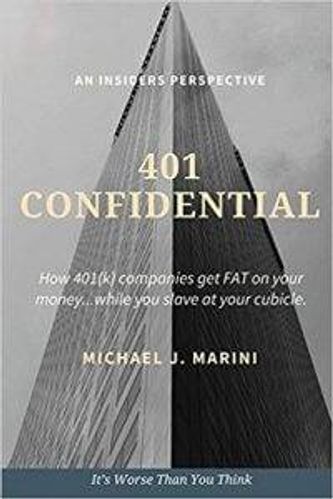The 7 Dirty Little Secrets of 401(k) Plans
The '401 Confidential' author on the $25 million charged in excessive fees
(The following is excerpted from 401 Confidential by Michael J. Marini.)

When you invest for retirement with a 401(k) plan, retirement plan companies get FAT on your money. By my estimate, roughly $25 million in excessive fees are being drained from the $2 billion in workplace retirement accounts. Here are seven Dirty Little Secrets of how this happens:
Dirty Little Secret No. 1: The Separate Account Charge
This Dirty Little Secret costs Americans more than $1 billion every year. It is found exclusively in retirement plans sold by life insurance companies. The average charge in the plans I have examined is a gut-punching 1.25 percent. But I have also seen a charge of a whopping 1.85 percent.
If your 401(k) plan is by a life insurance company, you are forced to pay this insidious fee. Look for keywords Group Variable Annuity, Separate Account Charge, Variable Account Charge, Mortality & Expense Charge. (These statements value your investments in “units,” not “shares.”)

Dirty Little Secret No. 2: Pricing Thresholds
401(k) providers often charge smaller businesses higher fees and reward them with fee reductions if their plan assets surpass pricing thresholds. They will tell you that they incur larger costs to service smaller plans. It is simply not true.
Taking you on as a client did not cause them to hire additional staff or expend additional money on infrastructure. It is simply their way of telling you they like to make a certain amount of money per client and you are not “it” for them.
Dirty Little Secret No. 3: Revenue Sharing
Revenue sharing is a process where money gets shared behind the scenes among the service providers to your plan. It’s a dead giveaway that you are being steered into high-cost investments and high administration fees.
Dirty Little Secret No. 4: High-Cost Plans With Low-Cost Names
Providers are not unwise to the notion that you might ask them to prove you are getting a good deal. One way they overcome this is by stocking your plan with low-cost investment names.
One ultra-high-cost plan I saw was stocked with an entire lineup of low-cost target-date funds and three index funds, but even though the target-date fund expense ratio [the total percentage of fund assets used for administrative, management, advertising and other costs], is just 0.16 percent and the index funds charge less, the provider got its client to agree to pay 3.03 percent in total participant fees.
Dirty Little Secret No. 5: Share Class Manipulation
This is the equivalent of being charged for premium gasoline at the pump and having regular gas pumped into your vehicle.
Share classes are the price tags on mutual funds. There are various share classes of each company’s funds, each designed for a specific investor application. When a retirement plan provider puts you in a high-cost share class and gambles you won’t notice, they do it so they can collect remuneration form the mutual fund company on top of the other money they already collect from you.
This practice is often a dirty side-component to revenue sharing. The chances of you noticing or even comprehending what they are doing to you are EXTREMELY low.
Retirement plans should always use the lowest-cost share class available. The lowest-cost share class at any mutual fund company pays only for the investment management services of the company. This means no remuneration passes from the fund company to the retirement plan provider. All other fees to your plan should then be itemized and attributed to the service provider receiving them.
Dirty Little Secret No. 6: Overpriced Advice
Investment advice services are being offered as an option inside many 401(k) plans. This is mostly referred to as a “Managed Account” service. This can be a good thing for people who do not have the confidence to select their own investments, but not if the price is too high.
I have seen advice offered for as high as 1 percent of your account value. If your account value is $200,000, is the advice worth $2,000 a year?
A simple risk-tolerance questionnaire will suffice to get most people invested properly. If you want the comfort of having someone advise you within your plan, an appropriately-priced service costs $79 a year.
Dirty Little Secret No. 7: The Long Game
What do you get when you take a bunch of powerful, well-lobbied retirement plan companies with teams of lawyers who stretch from here to the moon and pit them against millions of plan participants who are like drops of water in the ocean? You get “The Long Game.” It goes like this:
Get the clients to pay as much as they will agree to. Collect ridiculous sums of money year after years. Get sued by one out of 100,000 clients. Fight it out for years in court. Write a check only if the court makes you. Have a steak dinner and laugh it off. Repeat.

